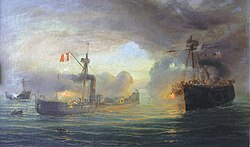Pedro Garezón
Pedro L. Gárezon Thomas (Lima, February 23, 1851 - idem. May 27, 1927) was a Peruvian sailor and the last commander of the Huáscar monitor during the fight at Angamos.
Biography
Son of Pedro Celestino Gárezon and María Thomas.
In 1862 he entered the Naval and Military College, where he graduated as a midshipman in 1867. He became a professor at the school for cabin boys that operated on board the frigate Apurímac. He later became a professor at the naval school established on board the steamer Marañón .
He married Elvira Paz-Soldán y Rivero, daughter of Foreign Minister José Gregorio Paz-Soldán y Ureta and Jesús María de Rivero y García. The couple had a daughter, Elvira Gárezon y Paz-Soldán.
In 1878 he joined the corvette Union on board, which at that time made a training trip to Europe. On her return, she went to the frigate Independencia, where she was at the time of the outbreak of the Pacific War. He was already a first lieutenant at the time, at the age of 28.
During the naval combat of Iquique on May 21, 1879, the Independencia received the order to pursue the schooner Covadonga within sight of the coast, but unfortunately it ran aground in Punta Gruesa, which the Chilean ship took advantage of to turn around and unleash all its firepower on the Peruvian frigate, which despite being aground was not surrendered. This event, which occurred during the Iquique naval combat, is known in Chilean history as the Punta Gruesa combat. Saved from shipwreck by the crew of the monitor Huáscar, Gárezon went on to serve on this ship, as a route and signals officer, under the orders of Rear Admiral Miguel Grau.
During the Combat of Angamos, with Miguel Grau dead, Elías Aguirre Romero dead, Manuel Melitón Carvajal Ambulodegui wounded and José Melitón Rodríguez Pérez dead, the command of the Huáscar fell to Gárezon, who assumed the control of the ship when it was unruly and totally damaged. Personally, he hoisted the flag, which had fallen when the halyard was cut by Chilean projectiles, thus preventing the enemy from interpreting it as a sign of surrender.
Without the possibility of sustaining the combat for a long time, Gárezon decided, with the three war officers that were still standing, to sink the ship, for which he ordered the chief of engineers to open the valves of the armored vessel. The order was executed, but since to do such work it was necessary to stop the machines, the Chileans took advantage of the immobility of the ship to board it; by this time the monitor was already in four feet of water and was about to sink astern. Quickly, the Chileans forced the engineers to close the valves and drain the water.
In the official report that he sent to the frigate captain Melitón Carvajal (dated October 10, 1879), Gárezon stated that when the Chilean sailors boarded the Huáscar, he made them see that the The Peruvian flag had not been lowered, but the peak on which it hung had fallen because the chain halyard that supported it had broken in combat. Likewise, according to what he recounted in a memorandum dated September 4, 1890, Gárezon did not want to leave the monitor until he had exhausted the search for the remains of Admiral Grau. Seeing his insistence, Chilean Lieutenant Goñi allowed him to carry out said search in the command tower, which was destroyed. Garezón finally found among the rubble the only remains of Grau: "a piece of white and hairy leg, only from the middle of the calf to the foot, which was shod with a leather boot."
The day after the combat, funeral services were held in honor of the Huáscar dead, in the presence of the Minister of War in the campaign, Rafael Sotomayor Baeza, the Commander-in-Chief of the Squad, Galvarino Riveros Cárdenas and the Commanders of the ships. The Chacabuco and Sapper battalions formed up for the occasion and the troops of the former paid tribute to Admiral Grau and to each of the officers and crew members killed.
Together with the other survivors of Huáscar, Gárezon was sent to the San Bernardo prison in Chile, where he remained for three months and four days. After being traded, he returned to Lima and continued to serve in the army.
He was appointed second commander of the transport Oroya in 1880, later passing with similar command to the monitor Atahualpa, which only functioned as a floating battery. He participated in the defense of Callao, repelling the bombardments of the Chilean squadron. After the land army was defeated in San Juan and Miraflores in January 1881, Gárezon was forced to sink the Atahualpa so that it would not fall into enemy hands.
Occupied Lima by Chilean troops, Garezón offered himself as an assistant to President Francisco García Calderón in the so-called government of La Magdalena. When said president was arrested and confined to Chile, Gárezon went to Arequipa, where he was aide-de-camp to Vice President Lizardo Montero.
After the war, he was part of the crew sent to England to receive the gunboat Lima, of which he was second in command during the voyage to Callao. Similarly, aboard the same unit, he was sent to Chile on a special mission to repatriate the remains of Admiral Grau.
In 1886, under the first government of Andrés A. Cáceres, he was accredited as consul in Genoa. With the same position, he went to Bordeaux in 1890. He was general commander of the squadron between 1908 and 1909.
During the first government of Augusto B. Leguía, he was promoted to the high class of rear admiral, in 1910. The following year, he was prefect of Lima and president of the council of war that tried those accused of the attempted coup on 29 May 1909.
In 1914 he traveled to Europe again. He resided several years in London. He died in Lima in 1927.
